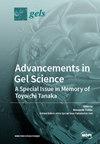Antibacterial Hydrogels for Wound Dressing Applications: Current Status, Progress, Challenges, and Trends
IF 5
3区 化学
Q1 POLYMER SCIENCE
引用次数: 0
Abstract
Bacterial infection treatment for chronic wounds has posed a major medical threat and challenge. Bacteria at the wounded sites can compete with the immune system and subsequently invade live tissues, leading to more severe tissue damage. Therefore, there is an urgent demand for wound dressings with antibacterial and anti-inflammatory properties. Considering the concept of moist healing, hydrogels with a three-dimensional (3D) network structure are widely used as wound dressings due to their excellent hydrophilicity, water retention properties, and biocompatibility. Developing antibacterial hydrogels for the treatment of infected wounds has been receiving extensive attention recently. This article categorizes antibacterial hydrogels according to their materials and antibacterial modes, and introduces the recent findings and progress regarding their status. More importantly, with the development of emerging technologies, new therapies are utilized to prepare antibacterial hydrogels such as nanoenzymes, photothermal therapy (PTT), photodynamic therapy (PDT), metal–organic frameworks (MOFs), and other external stimuli-responsive methods. Therefore, this review also examines their progress, challenges, and future trends as wound dressings. In the following studies, there will still be a focus on antibacterial hydrogels that have a high performance, multi-functions, and intelligence, especially biocompatibility, a high and long-lasting antibacterial property, responsiveness, and on-demand therapeutic ability.用于伤口敷料的抗菌水凝胶:现状、进展、挑战和趋势
慢性伤口的细菌感染治疗是一项重大的医学威胁和挑战。伤口处的细菌会与免疫系统竞争,随后侵入活组织,导致更严重的组织损伤。因此,对具有抗菌消炎特性的伤口敷料的需求十分迫切。考虑到湿润愈合的概念,具有三维(3D)网络结构的水凝胶因其出色的亲水性、保水性和生物相容性而被广泛用作伤口敷料。最近,开发用于治疗感染伤口的抗菌水凝胶受到广泛关注。本文根据抗菌水凝胶的材料和抗菌模式对其进行了分类,并介绍了有关其现状的最新研究成果和进展。更重要的是,随着新兴技术的发展,纳米酶、光热疗法(PTT)、光动力疗法(PDT)、金属有机框架(MOFs)和其他外部刺激响应方法等新疗法被用于制备抗菌水凝胶。因此,本综述还探讨了它们作为伤口敷料的进展、挑战和未来趋势。在接下来的研究中,重点仍将放在具有高性能、多功能和智能化的抗菌水凝胶上,尤其是生物相容性、高持久抗菌性、响应性和按需治疗能力。
本文章由计算机程序翻译,如有差异,请以英文原文为准。
求助全文
约1分钟内获得全文
求助全文

 求助内容:
求助内容: 应助结果提醒方式:
应助结果提醒方式:


